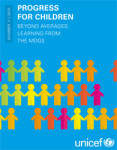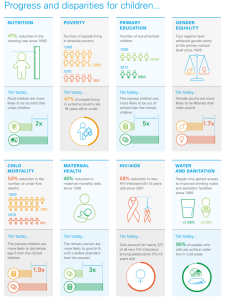The eleventh edition of Progress for Children Beyond Averages: Learning from the MDGs (No. 11) is UNICEF’s final report on the child-related Millennium Development Goals (MDGs). The report highlights both positive and negative aspects of the MDGs. For instance, though MDGs have helped drive tremendous advances in the lives of the world’s children, unequal opportunities have still left millions of children living in poverty, dying before they turn five, without schooling and suffering from chronic malnutrition.
- Under-five mortality dropped by more than half, from 90 per 1,000 live births to 43 per 1,000 live births;
- Underweight and chronic malnutrition among children under five decreased by 42 per cent and 41 per cent, respectively;
- Maternal mortality decreased by 45 per cent;
- Some 2.6 billion people gained access to improved drinking water sources.
- The gap in maternal mortality rates between low- and high-income countries halved between 1990 and 2013, from 38 times higher to 19 times higher.
Notable Areas for further improvement:
- Progress still eludes the nearly 6 million children who die every year before their fifth birthday;
- 289,000 women still die every year while giving birth;
- 58 million children still don’t go to primary school.
Continued failure to reach these children can have dramatic consequences. At current rates of progress, given projected population growth, it is estimated that:
- 68 million more children under five will die from mostly preventable causes by 2030;
- An estimated 119 million children will still be chronically malnourished in 2030;
- Half a billion people will still be defecating in the open, posing serious risks to children’s health in 2030;
- It will take almost 100 years for all girls from sub-Saharan Africa’s poorest families to complete their lower secondary education.

